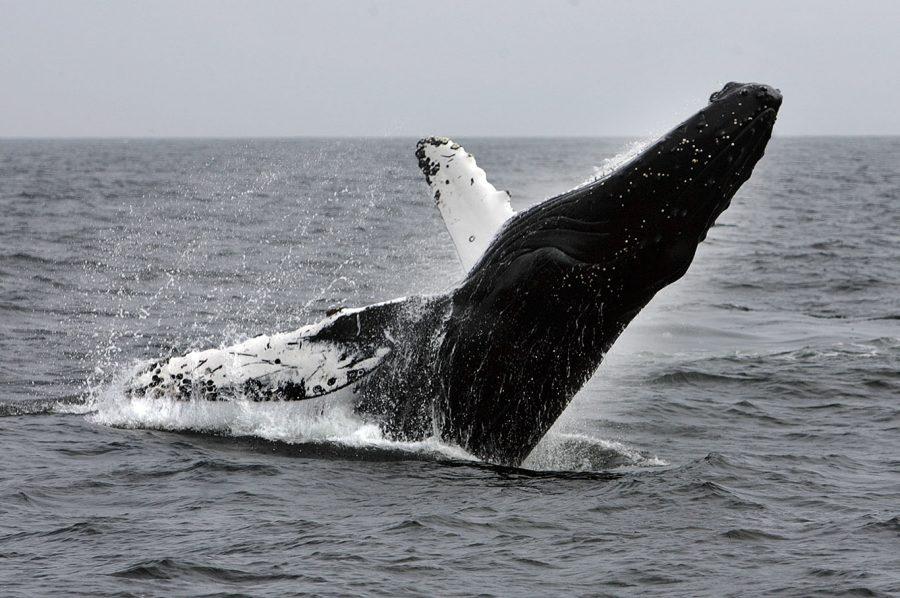Most humpback whale populations removed from US endangered species list
a Humpback whale breaches on the way back from a day trip on Anacapa Island, off the coast near Ventura, Calif., in May 2008. The U.S. government on Tuesday, Sept. 6, 2016, removed most of the world's humpback populations from the federal list of endangered species.(Spencer Weiner/Los Angeles Times/TNS)
September 8, 2016
In a triumph for the global movement to save whales from oblivion, the U.S. government on Tuesday removed most of the world’s humpback populations from the federal list of endangered species, with some glaring exceptions on the West Coast.
The National Oceanic and Atmospheric Administration announced that nine of 14 groups of whales around the globe have recovered to the point that they no longer qualify as endangered, though the giant mammals will still be protected from human hunting and other threats.
But the whales that feed and cavort off the shore of California, delighting whale-watchers and boosting coastal economies, were not taken off the list, because of ongoing threats posed by vessel collisions and fishing gear entanglements.
Still, Tuesday’s announcement served as a dramatic milepost in the decadeslong effort to restore humpbacks and other whales that were hunted almost to extinction by the mid-20th century.
“Today’s news is a true ecological success story,” said Eileen Sobeck, assistant administrator for fisheries for the National Oceanic and Atmospheric Administration.
The United States passed the Marine Mammal Protection Act in 1972, banning whale hunting, and humpbacks were among the animals protected in 1973 when President Richard Nixon signed the Endangered Species Act. The International Whaling Commission imposed a whaling moratorium in 1986.
Nowadays whale hunting has all but ceased, and humpbacks have made a major recovery. The total number of humpbacks has grown from as few as 5,000 in the 1960s to around 85,000 today, according to the latest NOAA rough estimates.
The graceful animals grow up to 60 feet long in maturity and are known for their athletic leaps, or breaches, long dorsal fins, and enigmatic underwater songs.
Four of the world’s 14 distinct populations of humpbacks — Central America, Hawaii, Mexico and Western North Pacific — spend time on the West Coast. The Central America and Mexico whales are the ones Californians glimpse swimming and leaping as they make their way to and from their winter feeding grounds in Canada and Alaska.
NOAA estimates the populations of the Central America and Mexico groups at 411 and 3,264, respectively. The number of Mexico humpbacks is increasing, while the population trend of the Central America whales is less clear.
The agency decided not to change the endangered status of the Central America humpbacks and downgraded the Mexico whales to “threatened,” though the latter will still get the same level of legal protection as before.
The top two threats to these whales appear to be ship strikes and entanglement in fishing ropes. Last year, there were 61 reports of entangled whales off the coasts of California, Oregon and Washington, the most since NOAA Fisheries started keeping records in 1982. Most of the incidents involved humpbacks, and the vast majority occurred in California.
Part of the reason for the increase in entanglements over the past couple years could be the distribution of the whales. This summer, Half Moon Bay residents watched in amazement as humpbacks that had followed schools of anchovies toward shore swallowed big gulps of fish as little as 100 feet from Miramar Beach.
Kristen Monsell, an attorney with the Center for Biological Diversity, said Monterey Bay has emerged as an entanglement hot spot. Most of the cases of trapped whales in California last year involved Dungeness crab gear.
“There’s been a steadily increasing trend of entanglements of large whales, including humpbacks, on the West Coast,” said Monsell. “You get a lot of overlap of whales and fishing gear in that area, which is just a recipe for disaster.”
Pillar Point fisherman Jim Anderson is a member of a state-sponsored working group studying possible modifications to fishing practices. Some rogue crab fishermen use more rope than is needed for a given depth of crab trap or employ extra buoys, he said.
“We’re trying to figure out ways to reduce the interaction with whales,” he said.
Other threats to the Central America and Mexico whales that are deemed low but increasing are harmful algae blooms, coastal development and human-generated noise.
Monsell said NOAA’s decision not to take California’s whales off the endangered species list is a wake-up call.
“We think this rule is an indication that a lot more needs to be done to protect these species,” she said. “They’re amazing animals, we’re lucky to share the water with them, and we need to do everything we can to protect them.”
















MacIntyre Felton • Sep 9, 2016 at 6:58 am
This is fantastic that thease beautiful creatures are making a rebout.The problem is that we are still weary about the future of their population. Just because it is no longer endangered, we still should treat it as it is, which is a necessity to help revive them past any sort of threatened status. Movements like th3se in the positive population direction is great because it shows the world that humans can make a difference and protect these animals!